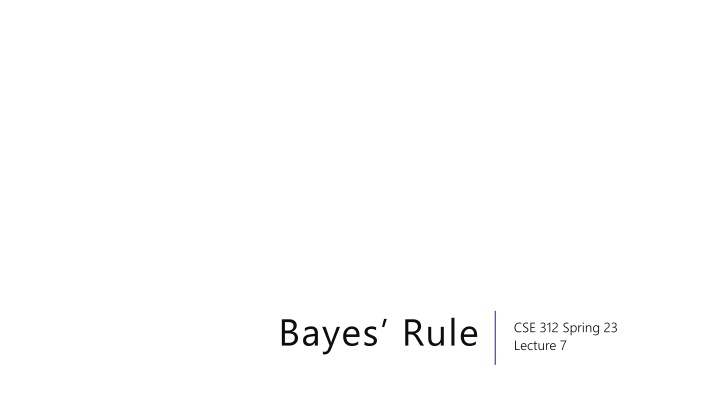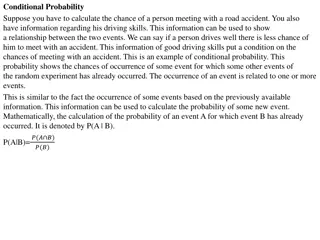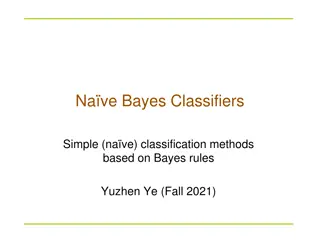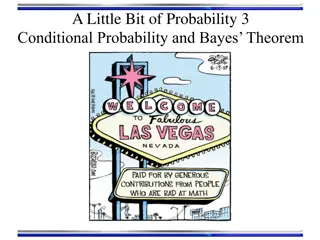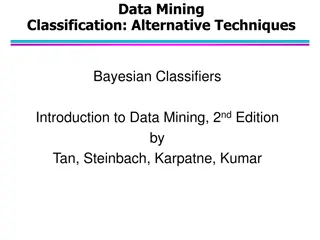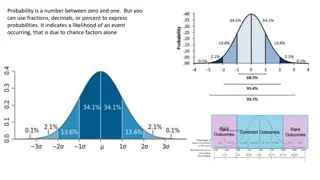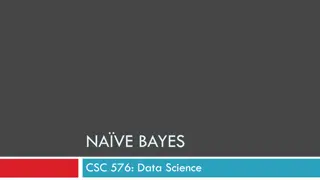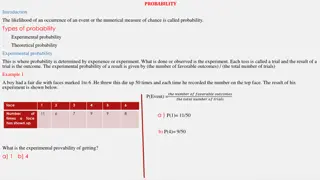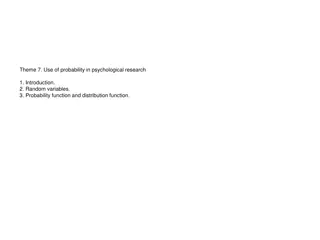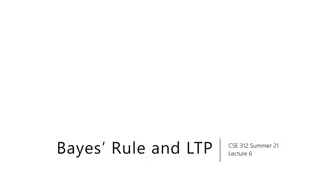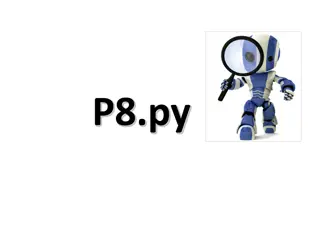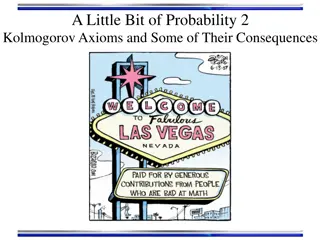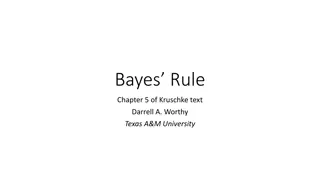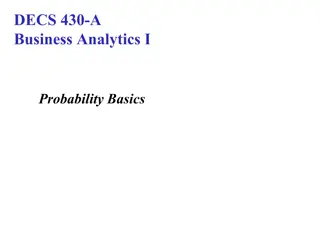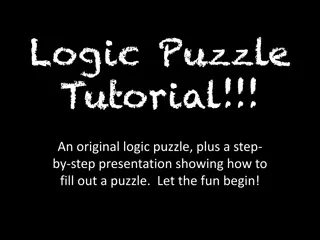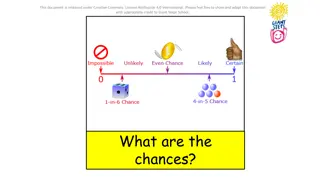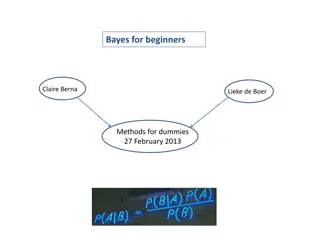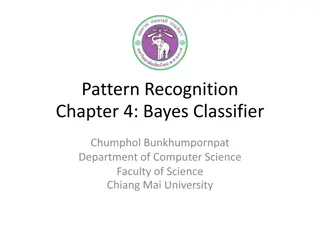Solving the Golden Ticket Probability Puzzle with Bayes' Rule
In this scenario, Willy Wonka has hidden golden tickets in his Wonka Bars. With the help of a precise scale that alerts accurately based on whether a bar has a golden ticket or not, we calculate the probability of having a golden ticket when the scale signals a positive result. By applying conditional probability concepts and Bayes' Rule, we unravel the solution step by step in an engaging learning exercise.
Download Presentation

Please find below an Image/Link to download the presentation.
The content on the website is provided AS IS for your information and personal use only. It may not be sold, licensed, or shared on other websites without obtaining consent from the author.If you encounter any issues during the download, it is possible that the publisher has removed the file from their server.
You are allowed to download the files provided on this website for personal or commercial use, subject to the condition that they are used lawfully. All files are the property of their respective owners.
The content on the website is provided AS IS for your information and personal use only. It may not be sold, licensed, or shared on other websites without obtaining consent from the author.
E N D
Presentation Transcript
Bayes Rule CSE 312 Spring 23 Lecture 7
Wonka Bars Willy Wonka has placed golden tickets on 0.1% of his Wonka Bars. You want to get a golden ticket. You could buy a 1000-or-so of the bars until you find one, but that s expensive you ve got a better idea! You have a test a very precise scale you ve bought. If the bar you weigh does does have a golden ticket, the scale will alert you 99.9% of the time. If the bar you weigh does not have a golden ticket, the scale will (falsely) alert you only 1% of the time. If you pick up a bar and it alerts, what is the probability you have a golden ticket?
Fill out the poll everywhere so Robbie knows how long to explain Go to pollev.com/cse312 Willy Wonka Willy Wonka has placed golden tickets on 0.1% of his Wonka Bars. If the bar you weigh does does have a golden ticket, the scale will alert you 99.9% of the time. If the bar you weigh does not have a golden ticket, the scale will (falsely) alert you only 1% of the time. You pick up a bar and it alerts, what is the probability you have a golden ticket? Which of these is closest to the right answer? A. 0.1% B. 10% C. 50% D. 90% E. 99% F. 99.9%
Conditioning Let ? be the event that the S Scale alerts you Let ? be the event your bar has a G Golden ticket. What conditional probabilities are each of these? Willy Wonka has placed golden tickets on 0.1% of his Wonka Bars. If the bar you weigh does does have a golden ticket, the scale will alert you 99.9% of the time. If the bar you weigh does not have a golden ticket, the scale will (falsely) alert you only 1% of the time. If you pick up a bar and it alerts, what is the probability you have a golden ticket?
Conditioning Let ? be the event that the S Scale alerts you Let ? be the event your bar has a G Golden ticket. What conditional probabilities are each of these? Willy Wonka has placed golden tickets on 0.1% of his Wonka Bars. If the bar you weigh does does have a golden ticket, the scale will alert you 99.9% of the time. If the bar you weigh does not have a golden ticket, the scale will (falsely) alert you only 1% of the time. You pick up a bar and it alerts, what is the probability you have a golden ticket? (?) (?|?) ? ? (?|?)
Reversing the Conditioning All of our information conditions on whether ? happens or not does your bar have a golden ticket or not? But we re interested in the reverse conditioning. We know the scale alerted us we know the test is positive but do we have a golden ticket?
Bayes Rule ? ? = (?|?) ? ?
Bayes Rule ? ? = (?|?) ? ? What do we know about Wonka Bars? (?|?) = ? ? (?) (?)
Bayes Rule ? ? = (?|?) ? ? What do we know about Wonka Bars? (?|?) =.999 .001 (?)
Filling In What s (?)? We ll use a trick called the law of total probability : ? = ? ? ? + ? = 0.999 .001 + .01 .999 = .010989 ? ?
Law of Total Probability Let ?1,?2, ,?? be a partition partition of . . A partition of a set ? is a family of subsets ?1,?2, ,?? such that: ?? ??= for all ?,? and ?1 ?2 ??= ?. i.e. every element of is in exactly one of the ??.
Law of Total Probability Law of Total Probability Let ?1,?2, ,?? be a partition of . For any event ?, ? = ?|?? (??) ??? ?
Why? ? ?1 ?3 ?2 The Proof is actually pretty informative on what s going on. all ? ?|?? (??) ? ?? ?? = all ? ? ?? = (?) The ?? partition , so ? ?? partition ?. Then we just add up those probabilities. Ability to add follows from the countable additivity axiom. (??) (definition of conditional probability) = all ?
Bayes Rule What do we know about Wonka Bars? (?|?) =.999 .001 .010989 1 11, i.e. about 0.0909. Solving ? ? = Only about a 10% chance that the bar has the golden ticket!
Willy Wonka has placed golden tickets on 0.1% of his Wonka Bars. If the bar you weigh does does have a golden ticket, the scale will alert you 99.9% of the time. If the bar you weigh does not have a golden ticket, the scale will (falsely) alert you only 1% of the time. Wait a minute That doesn t fit with many of our guesses. What s going on? Instead of saying we tested one and got a positive imagine we tested 1000. ABOUT ABOUT how many bars of each type are there? (about) (about) 1 with a golden ticket 999 without. Lets say those are exactly right. Lets just say that one golden is truly found (about) (about) 1% of the 999 without would be a positive. Lets say it s exactly 10.
Visually Gold bar is the one (true) golden ticket bar. Purple bars don t have a ticket and tested negative. Red bars don t have a ticket, but tested positive. The test is, in a sense, doing really well. It s almost always right. The problem is it s also the case that the correct answer is almost always no.
Updating Your Intuition Take 1: The test is actually good that there IS a golden ticket when you get a positive result. actually good and has VASTLY increased our belief If we told you your job is to find a Wonka Bar with a golden ticket without the test, you have 1/1000 chance, with the test, you have (about) a 1/11 chance. That s (almost) 100 times better! This is actually a huge improvement!
Updating Your Intuition Take 2: Humans are really bad at intuitively understanding very large or very small numbers. When I hear 99% chance , 99.9% chance , 99.99% chance they all go into my brain as well that s basically guaranteed And then I forget how many 9 s there actually were. But the number of 9s matters because they end up cancelling with the number of 9 s in the population that s truly negative. We ll talk about this a little more on Friday in the applications.
Updating Your Intuition Take 3: View tests as updating your beliefs, not as revealing the truth. Bayes Rule says that (?|?) has a factor of (?) in it. You have to translate The test says there s a golden ticket to the test says you should increase your estimate of the chances that you have a golden ticket. A test takes you from your prior beliefs of the probability to your posterior beliefs.
A contrived example You have three red marbles and one blue marble in your left pocket, and one red marble and two blue marbles in your right pocket. You will flip a fair coin; if it s heads, you ll draw a marble (uniformly) from your left pocket, if it s tails, you ll draw a marble (uniformly) from your right pocket. Let ? be you draw a blue marble. Let ? be the coin is tails. What is (?|?) what is (?|?) ?
Updated Sequential Processes You have three red marbles and one blue marble in your left pocket, and one red marble and two blue marbles in your right pocket. if it s heads, you ll draw a marble (uniformly) from your left pocket, if it s tails, you ll draw a marble (uniformly) from your right pocket. ? =1 ? =1 2 2 For sequential processes with probability, at each step multiply by next step all prior steps) H T ?|? =1 ?|? =3 ?|? =2 3 4 ?|? =1 3 4 ? ? = 1/6 ? ? = 3/8 ? ? = 1/3 ? ? = 1/8
Updated Sequential Processes You have three red marbles and one blue marble in your left pocket, and one red marble and two blue marbles in your right pocket. if it s heads, you ll draw a marble (uniformly) from your left pocket, if it s tails, you ll draw a marble (uniformly) from your right pocket. ? =1 ? =1 2 2 For sequential processes with probability, at each step multiply by next step all prior steps) H T ?|? =1 ?|? =3 ?|? =2 3 4 ?|? =1 3 4 ? ? = 2/3; ? =1 8+1 3=11 ? ? = 1/6 ? ? = 3/8 24 ? ? = 1/3 ? ? = 1/8
Flipping the conditioning You have three red marbles and one blue marble in your left pocket, and one red marble and two blue marbles in your right pocket. if it s heads, you ll draw a marble (uniformly) from your left pocket, if it s tails, you ll draw a marble (uniformly) from your right pocket. What about (?|?)? Pause, what s your intuition? Is this probability A. less than B. equal to C. greater than The right (tails) pocket is far more likely to produce a blue marble if picked than the left (heads) pocket is. Seems like (?|?) should be greater than .
Flipping the conditioning You have three red marbles and one blue marble in your left pocket, and one red marble and two blue marbles in your right pocket. if it s heads, you ll draw a marble (uniformly) from your left pocket, if it s tails, you ll draw a marble (uniformly) from your right pocket. What about (?|?)? Bayes Rule says: ? ? = (?|?) ? ? 2 3 1 2 = 11/24= 8/11
Proof of Bayes Rule ? ? = ? ? by definition of conditional probability ? Now, imagining we get ? ? by conditioning on ?, we should get a numerator of ? ? (?) = (?|?) ? ? As required.
A Technical Note After you condition on an event, what remains is a probability space. With ? playing the role of the sample space, (?|?) playing the role of the probability measure. All the axioms are satisfied (it s a good exercise to check) That means any theorem we write down has a version where you condition everything on ?.
An Example Bayes Theorem still works in a probability space where we ve already conditioned on ?. ? [? ?] ? ? (?|?) ? [? ?] =
A Quick Technical Remark I often see students write things like ([? ?] ?) This is not a thing. You probably want (?| ? ? ) ?|?isn t an event it s describing an event and the sample space. So you can t ask for the probability of that conditioned on something else. and telling you to restrict
Where Theres Smoke Theres There is a dangerous (you-need-to-call-the-fire-department- dangerous) fire in your area 1% of the time. If there is a dangerous fire, you ll smell smoke 95% of the time; If there is not a dangerous fire, you ll smell smoke 10% of the time (barbecues are popular in your area) If you smell smoke, should you call the fire department?
? be the event you smell smoke ? be the event there is a dangerous fire ? ? = (?|?) ? (?|?) ? = ? ? ? + ? ? ? (?) .95 .01 = .95 .01+.1 .99 .088 Probably not time yet to call the fire department.
